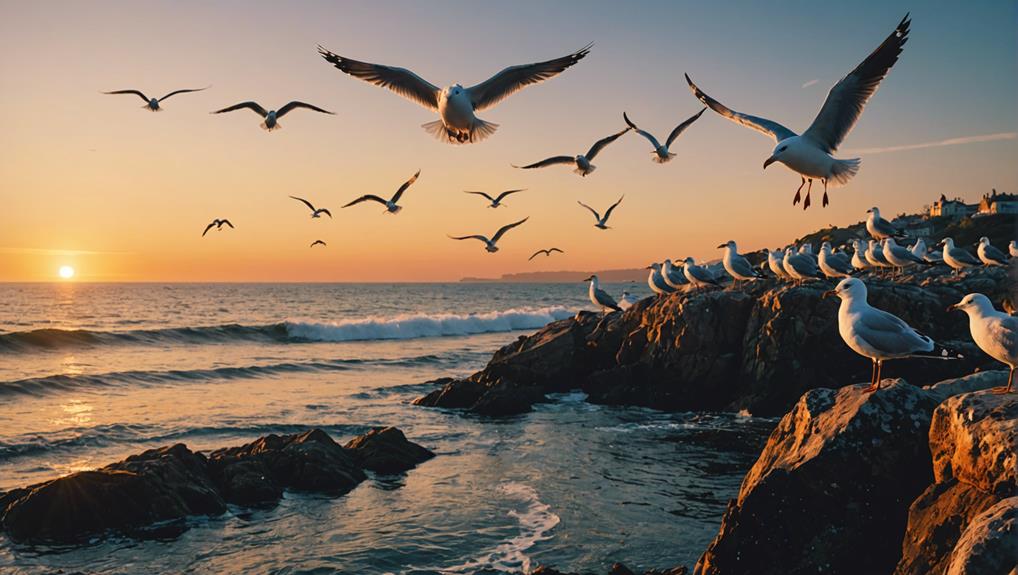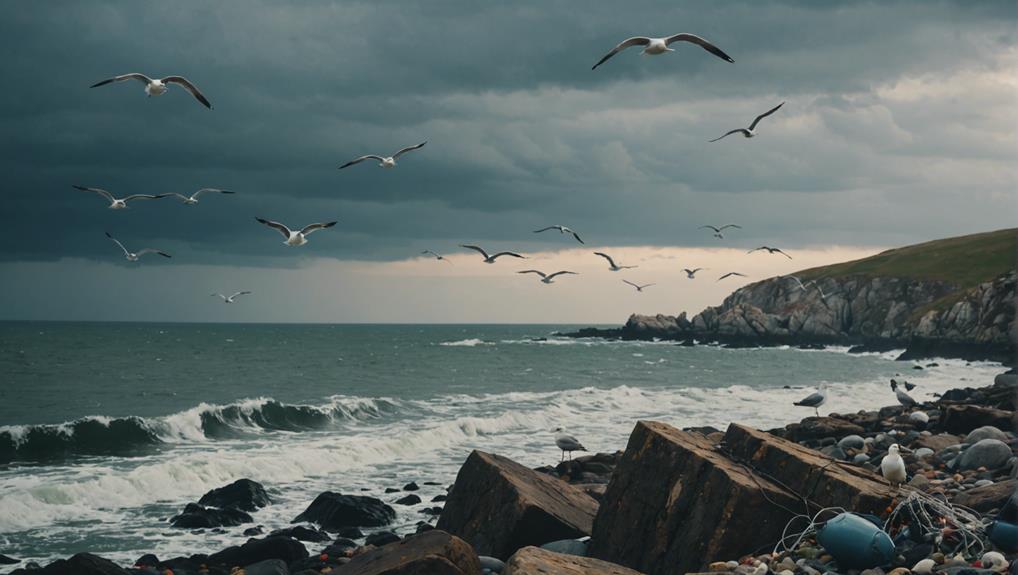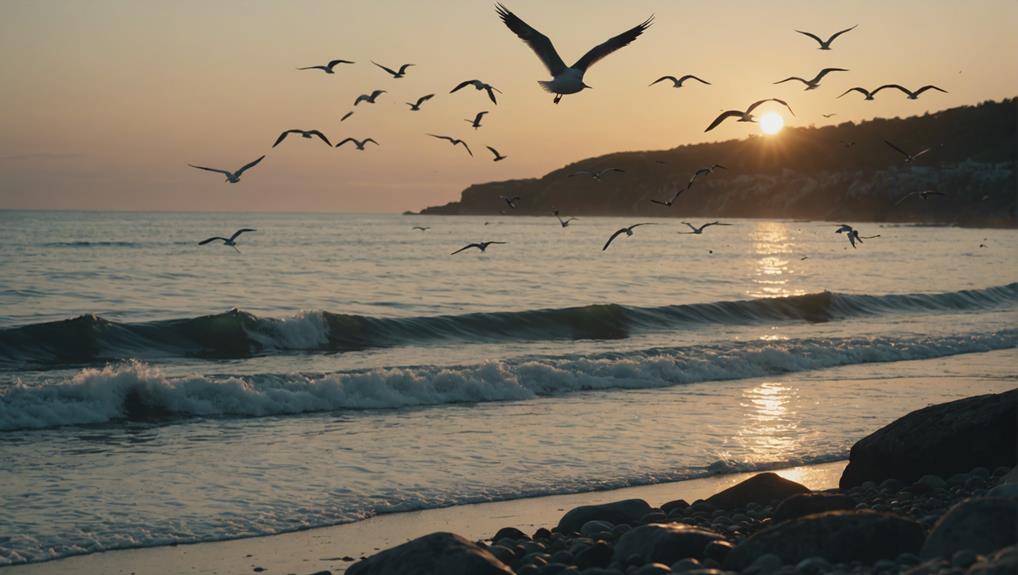Seagulls, known for their adaptability, can live between 10 and 20 years in the wild. However, diverse factors such as food availability, environmental conditions, and predation heavily influence their lifespan. Urban environments and controlled settings often allow some individuals to reach even greater lifespans due to consistent food sources and reduced threats. Different species, like the herring gull, commonly fall within this lifespan range. By studying their plumage and behavior, scientists can determine their longevity and monitor their lifespans. Understanding these fascinating birds and their life cycles offers intriguing insights into their survival strategies and interactions with the environment.
Seagull Lifespan Overview
Seagulls' lifespans typically range from 10 to 20 years in the wild, contingent upon factors such as food availability, predation, and environmental conditions. These adaptable birds have developed survival strategies that allow them to thrive in different habitats, from coastal areas to urban environments. However, their lifespan can be greatly influenced by several factors, including their access to food and the presence of predators.
In the wild, seagulls face numerous challenges that can impact their longevity. A vital food supply is essential, as it guarantees that these birds have the necessary energy to forage, reproduce, and evade predators. Predation is another important factor; seagulls must constantly be on the lookout for threats from larger birds, mammals, and even humans.
Interestingly, seagulls in captivity, such as those in zoos, often live longer than their wild counterparts. This increased lifespan is attributed to the controlled environment, consistent food supply, and absence of predators.
Notable individuals, like a herring gull named Gull Dick, have been observed visiting the same location for 24 years, highlighting the potential for extended lifespans under favorable conditions. While many seagulls live within the typical range, some surpass expectations, demonstrating remarkable longevity.
Longevity Factors
Several critical factors influence the longevity of seagulls, shaping their survival and lifespan in both wild and captive environments. One key factor is the availability of food sources. Seagulls that have access to abundant and consistent food supplies tend to live longer, as they are less likely to suffer from malnutrition or starvation.
In the wild, seagulls often rely on natural food sources, such as fish and marine invertebrates, but human activity has also provided them with additional options like discarded food and waste.
Another significant factor is the seagulls' mating behavior. Seagulls are known to mate for life, forming long-term pair bonds that can improve their survival chances. These bonds can lead to more effective parenting and protection of their offspring, increasing the odds of young seagulls reaching adulthood.
Environmental factors, such as the presence of predators and harsh weather conditions, also play a crucial role in determining seagull longevity. Seagulls living in safer, more stable environments are likely to enjoy longer lifespans.
Furthermore, captive seagulls in zoos, benefiting from regular food supplies and protection from predators, often have longer lifespans compared to their wild counterparts.
Lifespan by Species

Different species of seagulls exhibit varying lifespans, influenced by their unique ecological niches and adaptive behaviors. For example, the herring gull, one of the most common species of gulls, typically lives 10-20 years in the wild. However, the oldest known herring gull astonishingly reached the stage of 49 years, showcasing the potential for remarkable longevity under ideal conditions.
Factors such as food availability, predator presence, and environmental conditions play important roles in determining the lifespan of different gull species. In the case of herring gulls, they often thrive in coastal regions where food is plentiful, while other species may inhabit more challenging environments that impact their survival rates. Consequently, variations in habitat and lifestyle contribute to the differing lifespans observed among distinct species of gulls.
Additionally, seagulls kept in captivity, such as those in zoos, tend to surpass the lifespans of their wild counterparts due to consistent food supply and protection from natural threats. It is also remarkable that once seagulls survive their initial year, their chances of reaching an advanced stage increase significantly. Documented instances of seagulls living beyond their expected years further emphasize the adaptability and resilience of these avian species.
Age Identification
Identifying the maturity of seagulls involves a detailed examination of their plumage, bill coloration, and physical condition. Age identification in seagulls is closely linked to observing specific changes over time. Juvenile seagulls, for instance, have mottled or darker feathers, which progressively lighten as they mature. This transformation in plumage color is a reliable indicator of the bird's stage in life.
Additionally, the coloration of a seagull's bill provides important age-related information. Younger seagulls typically sport darker bills, which gradually turn yellow or red as they grow older, offering another visual cue for age determination. Experts also consider the seagull's physical condition, such as the clarity of their eyes, muscle tone, and general health, which can hint at their maturity and longevity.
Banding studies play a significant role in understanding seagull populations and tracking individual bird ages. By attaching small, uniquely numbered bands to the legs of seagulls, researchers can gather valuable data on their lifespans and migratory patterns.
Observing behavior and social interactions within colonies further aids experts in estimating a seagull's maturity, as experienced birds exhibit different social cues compared to their younger counterparts.
Common Threats

Seagulls encounter a multitude of common threats that jeopardize their survival and well-being. One of the primary dangers comes from natural predators, including falcons, eagles, and even larger gulls, which prey on both adult seagulls and their chicks.
However, human activities pose even more significant risks to these resilient birds. Habitat destruction due to urban development and pollution disrupts their nesting sites and food sources, making it harder for seagulls to thrive.
Additionally, the pervasive issue of plastic debris in our oceans and on shorelines presents a dire threat. Seagulls often mistake plastic items for food, ingesting them and suffering from severe health problems or even death. This problem is compounded by other pollutants, such as oil spills that coat their feathers, impairing their ability to fly and stay buoyant.
Several critical threats to seagulls include:
- Predators: Falcons, eagles, and larger gulls
- Habitat destruction: Urban development and pollution
- Plastic debris: Ingestion leading to health issues
Survival Strategies
Many survival strategies employed by seagulls are crucial for maneuvering the myriad threats they face in their natural habitats. Herring gulls, for instance, are known for their resourcefulness and adaptability. One key strategy is their opportunistic feeding habits; they consume a wide variety of foods including fish, insects, and human refuse, which helps them survive in diverse environments. This broad diet increases their chances of finding food, even when one source becomes scarce.
Factors such as food availability, predators, and weather greatly influence seagull lifespan. Young seagulls, particularly in their initial year, face higher mortality rates due to their inexperience in evading predators and securing food. However, once they survive this critical period, their chances of reaching maturity and living longer improve substantially.
Instances of seagulls living beyond their typical lifespan, such as the herring gull named Gull Dick who visited the same place for 24 years, highlight the effectiveness of their survival strategies. The ability to navigate and return to familiar, resource-rich areas showcases their remarkable memory and learning capabilities. Such strategies are crucial for enduring the challenges posed by their ever-changing environments.
Urban Adaptation

Amidst the bustling urban landscape, seagulls have demonstrated remarkable adaptability by thriving in environments teeming with human activity. Urban areas offer seagulls a variety of opportunities to find food and shelter, impacting their health and safety. Seagulls have become proficient at exploiting human-generated food sources, often scavenging near dumpsters and nesting on rooftops.
This urban adaptation, however, comes with its own set of challenges and risks. On one hand, the abundance of food sources in cities can help seagulls live over 15 years. On the other hand, urban seagulls face dangers such as road accidents, which can lead to untimely demise. Moreover, their close proximity to human activity raises several health and safety concerns. Seagulls in urban areas have been found to be responsible for E-coli contamination and are carriers of antibiotic-resistant bacteria.
Key aspects of urban adaptation include:
- Nesting on rooftops which provides a safe haven away from predators.
- Scavenging near dumpsters that offer an almost constant supply of food.
- Navigating city streets and parks where leftover food is abundant.
Diet and Longevity
Diet plays a key role in determining the longevity of seagulls, influencing both their health and survival rates. The herring gull, a common species, exemplifies the impact of diet on lifespan. In the wild, seagulls have a varied diet that includes fish, marine invertebrates, and scavenged human food. Access to a nutritious and balanced diet is important for ensuring their general health and improving their chances of living longer.
Seagulls that have access to abundant and high-quality food sources are more likely to reach the upper limits of their natural lifespan, which typically ranges from 10 to 20 years. The oldest recorded herring gull, which lived for 49 years, underscores the potential longevity achievable under ideal conditions. However, the availability and quality of food can fluctuate due to environmental factors, such as weather and human interference, which in turn affects their survival rates.
In captivity, where diet can be carefully managed and predators are absent, seagulls often live longer than their wild counterparts. Ensuring a balanced diet rich in necessary nutrients can greatly improve their health and longevity. Therefore, diet remains an important factor in determining how long seagulls, especially herring gulls, can live.
Breeding and Lifespan

Breeding practices greatly influence the entire lifespan of seagulls, impacting their survival and reproductive success. Typically, seagulls begin breeding at around three to five years of age. The breeding season plays a critical role in determining their general lifespan, as it is fraught with different challenges and factors that can affect their longevity.
Several key factors influence the breeding success and subsequent lifespan of seagulls:
- Food availability: Abundant food sources are essential during breeding seasons, as both parents and chicks require substantial nutrition to thrive.
- Weather conditions: Severe weather can affect nesting sites and food accessibility, thereby influencing breeding success and survival rates.
- Predators: Natural predators pose significant risks to eggs and chicks, impacting the overall breeding success and longevity of seagull populations.
Survival chances significantly increase after the initial year of life for seagulls in the wild. This is attributed to their growing experience in evading predators and finding food. Captive seagulls, often sheltered from these factors, tend to have longer lifespans compared to their wild counterparts.
Some seagulls have been recorded to live well beyond the typical range, showcasing the potential for individual variation in longevity. Understanding these breeding and lifespan dynamics is essential for comprehending the life cycle of seagulls.
Conservation Efforts
Given the significant impact of breeding practices on seagull longevity, targeted conservation efforts are important to guarantee their continued survival and ecological role. Conservation efforts for diverse seagull species focus on protecting their habitats, reducing human impact, and promoting responsible wildlife interaction. Organizations dedicated to these efforts work tirelessly to raise awareness about the importance of seagulls in ecosystems and the numerous threats they face, such as habitat destruction and pollution.
Conservation measures encompass monitoring seagull populations, studying their behaviors, and implementing sustainable management practices. These initiatives aim to balance human needs with seagull preservation, particularly in the face of challenges like urbanization and climate change. By carefully managing these factors, conservationists hope to mitigate the adverse effects of human impact on seagull species.
Collaborative efforts between researchers, conservationists, and the public are vital for the long-term success of these conservation projects. Through collective action, it is possible to safeguard the habitats of seagulls, ensuring their survival and continued contribution to the ecological balance.
Frequently Asked Questions
What Is the Maximum Age of Seagulls?
Seagulls typically live between 10 to 20 years in the wild, but the maximum lifespan can reach much higher under certain conditions. The oldest recorded herring gull lived for an impressive 49 years.
Survival rates increase notably after their initial year. Curiously, seagulls in captivity often outlive their wild counterparts, benefiting from consistent food and protection from predators.
Therefore, while rare, seagulls can live well beyond their average lifespan.
What's the Average Lifespan of a Seagull?
The average lifespan of a seagull ranges from 10 to 20 years in the wild. Factors such as environment, availability of food, and predation risks play vital roles in determining their longevity.
Species like the herring gull can live notably longer, with some reaching up to 49 years.
Surprisingly, seagulls tend to live longer in captivity due to controlled conditions, consistent food supply, and absence of predators.
What Is the Longest Living Seagull?
The longest living seagull on record is a herring gull that reached an impressive age of 49 years.
Typically, seagulls in the wild face numerous challenges, but those in captivity tend to live longer.
Individual lifespans can vary considerably, as seen in notable cases like Gull Dick, who returned to the same location for 24 years.
These instances highlight the remarkable longevity some seagulls can achieve under favorable conditions.
Are Seagulls Intelligent?
Yes, seagulls are intelligent. They exhibit impressive problem-solving skills and adaptability, thriving in diverse environments. These birds communicate through varied calls and body language and demonstrate complex social behaviors.
Seagulls also teach their young crucial survival and hunting skills. Their ability to learn and exploit human schedules and food sources in urban settings further underscores their cognitive abilities, showcasing their remarkable intelligence and adaptability.

